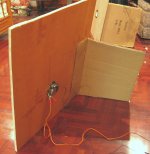Interesting experiments, thanks for posting them. The only material I know of that has been used on instruments instead of wood is a carbon fiber material used for some guitar tops. I know many guitar makers adjust the resonances of their instruments by shaving down the bracing under the sound board. They start with a thin top that's more flexible than desired and brace it with spruce strips to add strength and stiffness. Then the braces can be shaved down gradually until the sound is the way they want. Somewhere in my notes I have an article by a luthier describing a way to tell where to shave by temporarily adding mass to the braces. I could find it if you're interested. It was published in one of the GAL's big red books I think.
Test support of OB
since these were Tests to see
differences in Quality of Wood and
Thicknesses, i wanted MIN. Interaction
from anything else.....
hence, as you can see from the blurry fotos,
only one small cardboard pc attached with
good 3M tape on backside to angle it,
and point the plank at me.
thanks
k
since these were Tests to see
differences in Quality of Wood and
Thicknesses, i wanted MIN. Interaction
from anything else.....
hence, as you can see from the blurry fotos,
only one small cardboard pc attached with
good 3M tape on backside to angle it,
and point the plank at me.
thanks
k
Attachments
Cal Weldon said:Thanks for the update k. One more question: How is this board being supported? Is there any sort of bracing? Do you have a pic or two?
I guess that's 3 questions.
Here is how I braced my OB Fostex 126e speakers.I also made a dedicated stand for them with spikes up front to make them lean back ma little.One large brace in the middle with one smaller brace on either side.

To Kaybee,
Just a note to let you know I haven't forgotten about you. I haven't found that book yet, but looking through some others I see the added mass procedure was described in an acoustics book, not the GAL book. The section discusses the resonant modes of a flat, rectangular piece of wood. If you wish to drop the frequency of a particular mode you add mass to the area with the greatest movement. Adding mass to a node (area of least movement) has no effect on the frequency of that mode.
You can also remove material at the same spot. Removing material makes the wood lighter, which would make it vibrate faster, but it also reduces it's stiffness, which makes it vibrate slower. It turns out the effect from the reduced stiffness dominates so shaving off wood makes the resonant frequency drop, just like adding mass in the same spot. There was a simple mathematical relationship between added mass and the mass of material to remove to achieve the same effect, but I don't have the book with me right now.
Some luthiers try to tune the resonances to specific frequencies, I know the article I'm looking for tried to do this. Other luthiers try to bring out as many distinct resonances as possible without frequency measuring. Here is a good article about that from Dana Bourgeois http://www.pantheonguitars.com/stillvoicingstilldreaming.htm
I'll have a look in the garage for that book this weekend, a lot of my books are in storage out there.
Just a note to let you know I haven't forgotten about you. I haven't found that book yet, but looking through some others I see the added mass procedure was described in an acoustics book, not the GAL book. The section discusses the resonant modes of a flat, rectangular piece of wood. If you wish to drop the frequency of a particular mode you add mass to the area with the greatest movement. Adding mass to a node (area of least movement) has no effect on the frequency of that mode.
You can also remove material at the same spot. Removing material makes the wood lighter, which would make it vibrate faster, but it also reduces it's stiffness, which makes it vibrate slower. It turns out the effect from the reduced stiffness dominates so shaving off wood makes the resonant frequency drop, just like adding mass in the same spot. There was a simple mathematical relationship between added mass and the mass of material to remove to achieve the same effect, but I don't have the book with me right now.
Some luthiers try to tune the resonances to specific frequencies, I know the article I'm looking for tried to do this. Other luthiers try to bring out as many distinct resonances as possible without frequency measuring. Here is a good article about that from Dana Bourgeois http://www.pantheonguitars.com/stillvoicingstilldreaming.htm
I'll have a look in the garage for that book this weekend, a lot of my books are in storage out there.
- Status
- This old topic is closed. If you want to reopen this topic, contact a moderator using the "Report Post" button.
- Home
- Loudspeakers
- Full Range
- 15mm vs 20mm Plywood for OB

![IMGDEAD]](/community/proxy.php?image=http%3A%2F%2F%5BIMGDEAD%5Dhttps%3A%2F%2Fi51.photobucket.com%2Falbums%2Ff382%2Felfaudio%2FIM000803.jpg%5B%2FIMGDEAD%5D&hash=430d3d9814dbacb7eb89f9a8d6098ab0)